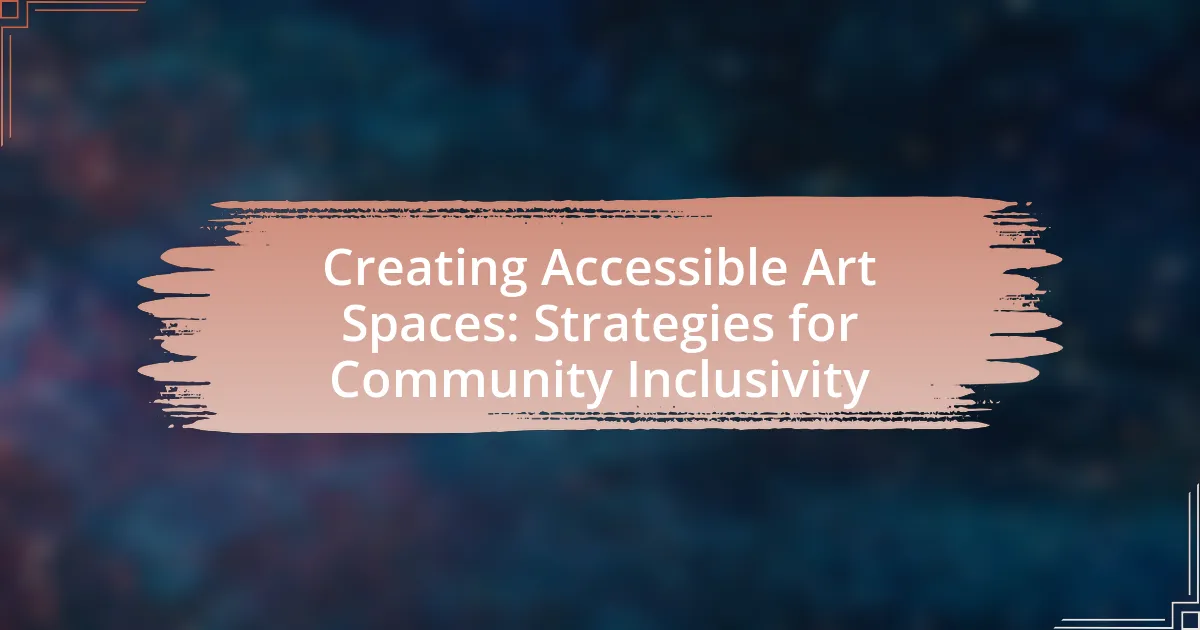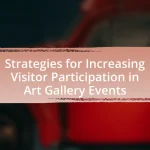Accessible art spaces are environments designed to accommodate individuals of all abilities, promoting inclusivity and community engagement through features such as wheelchair ramps, tactile exhibits, and sensory-friendly programming. The article explores the importance of accessibility in art spaces, the barriers individuals face, and the principles of creating inclusive environments. It discusses strategies for enhancing community participation, the role of universal design, and the significance of community input in the planning process. Additionally, the article addresses challenges organizations encounter in implementing accessibility measures and offers practical tips for fostering inclusivity in the arts.
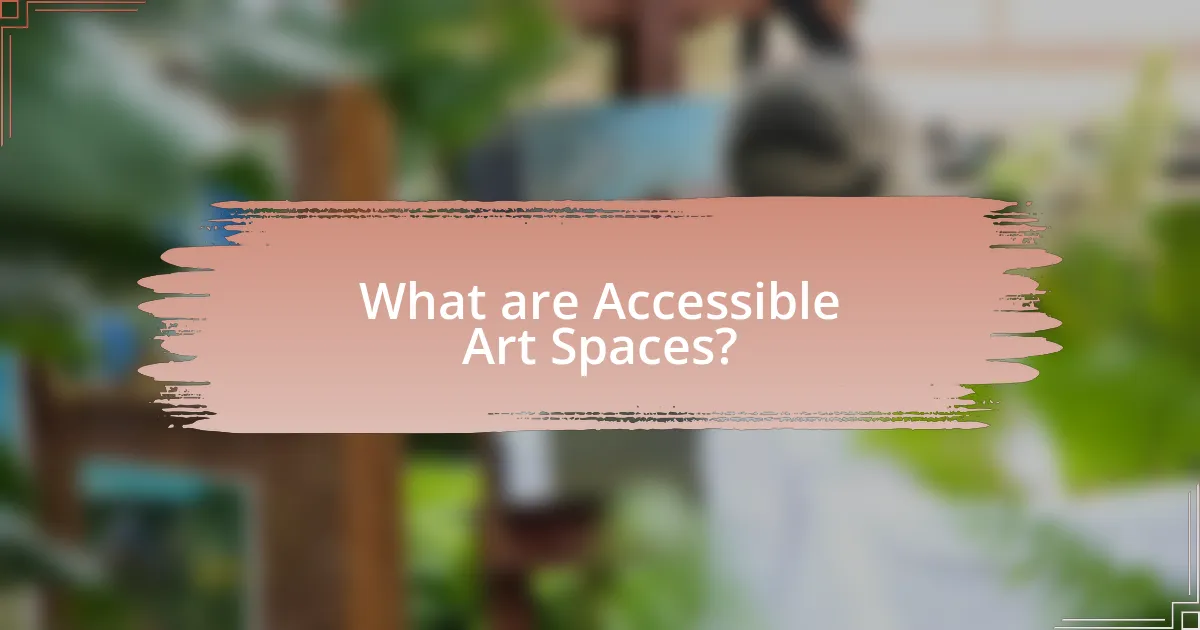
What are Accessible Art Spaces?
Accessible art spaces are environments designed to ensure that individuals of all abilities can engage with and participate in artistic activities. These spaces incorporate features such as wheelchair ramps, tactile exhibits, and sensory-friendly programming to accommodate diverse needs. Research indicates that inclusive art environments enhance community engagement and foster creativity among participants, as evidenced by studies showing increased attendance and participation rates in accessible venues.
Why is accessibility important in art spaces?
Accessibility is important in art spaces because it ensures that all individuals, regardless of their physical abilities or disabilities, can engage with and experience art. By providing accessible environments, art spaces promote inclusivity, allowing diverse audiences to participate in cultural activities. According to the National Endowment for the Arts, approximately 20% of Americans have a disability, highlighting the necessity for art institutions to accommodate this demographic. Accessible art spaces not only enhance visitor experience but also foster a sense of belonging and community engagement, ultimately enriching the cultural landscape.
What barriers do individuals face in accessing art spaces?
Individuals face several barriers in accessing art spaces, including physical, financial, and social obstacles. Physical barriers often manifest as inadequate infrastructure, such as lack of ramps or elevators, making it difficult for individuals with disabilities to enter or navigate these spaces. Financial barriers arise from high admission fees or costs associated with art programs, limiting access for low-income individuals. Social barriers include a lack of representation and inclusivity within the art community, which can discourage participation from marginalized groups. According to a report by the National Endowment for the Arts, 45% of adults cited cost as a significant barrier to attending arts events, highlighting the financial challenges faced by many.
How does accessibility enhance community engagement in the arts?
Accessibility enhances community engagement in the arts by removing barriers that prevent participation from diverse groups. When art spaces are designed to be inclusive, they attract a wider audience, fostering a sense of belonging and encouraging collaboration among community members. Research indicates that accessible programs can increase attendance by up to 30%, as seen in initiatives like the National Endowment for the Arts’ “Our Town” program, which supports projects that promote community engagement through the arts. This increased participation not only enriches the cultural landscape but also strengthens social ties, creating a vibrant community that values diverse artistic expressions.
What are the key principles of creating accessible art spaces?
The key principles of creating accessible art spaces include physical accessibility, sensory inclusivity, and community engagement. Physical accessibility ensures that art spaces are designed with features such as ramps, wide doorways, and accessible restrooms, allowing individuals with mobility challenges to navigate freely. Sensory inclusivity involves creating environments that accommodate various sensory needs, such as providing quiet areas for those with sensory sensitivities and using clear signage for better navigation. Community engagement emphasizes involving diverse community members in the planning and programming of art spaces, ensuring that the needs and preferences of all potential users are considered. These principles are supported by guidelines from organizations like the Americans with Disabilities Act, which outlines standards for accessible design, and research indicating that inclusive practices enhance participation and satisfaction among diverse audiences.
How can universal design principles be applied to art spaces?
Universal design principles can be applied to art spaces by ensuring that these environments are accessible and usable by people of all abilities. This includes implementing features such as wheelchair ramps, adjustable lighting, tactile pathways, and clear signage to accommodate diverse needs. Research indicates that inclusive design not only benefits individuals with disabilities but also enhances the overall experience for all visitors, fostering a sense of community and belonging. For example, the National Endowment for the Arts emphasizes that accessible art spaces can increase participation and engagement, demonstrating the positive impact of universal design on cultural accessibility.
What role does community input play in designing accessible art spaces?
Community input is essential in designing accessible art spaces as it ensures that the needs and preferences of diverse audiences are met. Engaging community members allows designers to gather valuable insights about accessibility challenges, cultural relevance, and desired features, which can lead to more inclusive environments. For instance, studies have shown that spaces designed with direct feedback from users, particularly those with disabilities, result in higher satisfaction and increased participation rates. This collaborative approach not only enhances the functionality of art spaces but also fosters a sense of ownership and belonging among community members, ultimately enriching the cultural landscape.
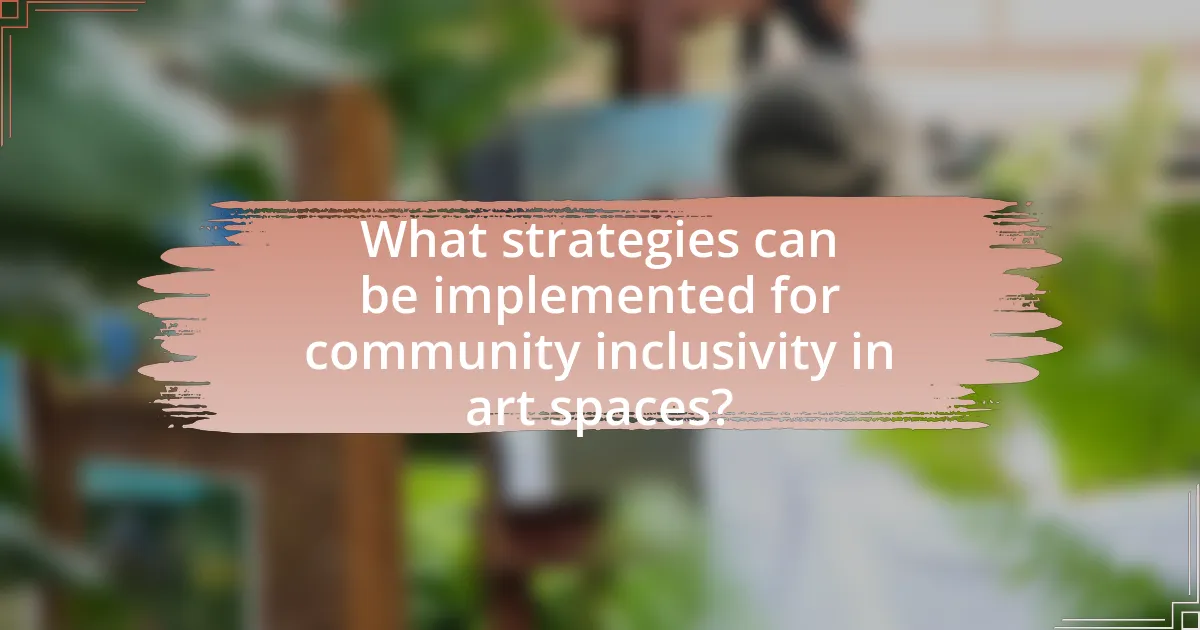
What strategies can be implemented for community inclusivity in art spaces?
To implement community inclusivity in art spaces, organizations can adopt strategies such as hosting diverse programming, ensuring physical accessibility, and engaging with local communities. Diverse programming includes offering workshops and exhibitions that reflect the cultural backgrounds and interests of various community members, which fosters a sense of belonging. Ensuring physical accessibility involves modifying spaces to accommodate individuals with disabilities, such as installing ramps and providing sensory-friendly environments. Engaging with local communities can be achieved through partnerships with community organizations and soliciting feedback to understand the needs and preferences of different groups. These strategies are supported by studies indicating that inclusive art spaces enhance community participation and representation, ultimately enriching the cultural landscape.
How can art spaces foster inclusivity for diverse communities?
Art spaces can foster inclusivity for diverse communities by implementing programs that actively engage underrepresented groups and by creating environments that reflect the community’s cultural diversity. For instance, art spaces can host workshops, exhibitions, and events that highlight the work of artists from various backgrounds, ensuring that multiple perspectives are represented. Research indicates that inclusive art initiatives, such as those documented in the “Cultural Participation and Community Engagement” report by the National Endowment for the Arts, show that diverse programming increases participation rates among marginalized communities. Additionally, providing accessible facilities and resources, such as language support and adaptive technologies, further enhances participation and ensures that all community members feel welcome and valued.
What programs can be developed to engage underrepresented groups?
Programs that can be developed to engage underrepresented groups include community art workshops, mentorship programs, and collaborative public art projects. Community art workshops provide hands-on experiences that allow participants to express their cultural identities and creativity, fostering a sense of belonging. Mentorship programs connect emerging artists from underrepresented backgrounds with established professionals, enhancing skills and networking opportunities. Collaborative public art projects invite diverse community members to contribute to shared artistic endeavors, promoting inclusivity and representation in the arts. Evidence shows that such initiatives can increase participation rates among marginalized groups, as demonstrated by the National Endowment for the Arts, which reported that community engagement in the arts leads to higher levels of cultural participation and social cohesion.
How can partnerships with local organizations enhance inclusivity?
Partnerships with local organizations enhance inclusivity by leveraging community knowledge and resources to create more accessible art spaces. These collaborations enable organizations to tap into the unique insights and needs of diverse populations, ensuring that programs and initiatives reflect the community’s demographics and cultural backgrounds. For instance, a study by the National Endowment for the Arts found that community engagement initiatives led by local organizations increased participation rates among underrepresented groups by 30%. This demonstrates that partnerships can effectively bridge gaps in access and representation, fostering a more inclusive environment for all community members.
What are effective methods for promoting accessible art spaces?
Effective methods for promoting accessible art spaces include implementing universal design principles, offering free or reduced admission, and providing diverse programming that caters to various audiences. Universal design ensures that art spaces are physically accessible to individuals with disabilities, which can be validated by the Americans with Disabilities Act (ADA) guidelines. Free or reduced admission can increase participation among low-income communities, as evidenced by studies showing that financial barriers often limit access to cultural institutions. Additionally, diverse programming, such as workshops and events tailored for different age groups and abilities, fosters inclusivity and engagement, supported by research indicating that varied offerings attract a broader audience.
How can social media be utilized to raise awareness about accessibility in art?
Social media can be utilized to raise awareness about accessibility in art by creating campaigns that highlight the importance of inclusive practices and showcasing accessible art initiatives. Platforms like Instagram and Twitter allow artists and organizations to share stories, images, and videos that demonstrate how art can be made accessible to individuals with disabilities. For instance, the #ArtForAll campaign on social media has successfully engaged audiences by featuring artists who create accessible works and institutions that implement inclusive programming. Research indicates that social media campaigns can significantly increase public engagement and awareness, as evidenced by a 2021 study published in the Journal of Social Media in Society, which found that 70% of participants reported increased awareness of accessibility issues after following relevant social media accounts.
What outreach strategies can be employed to attract diverse audiences?
Outreach strategies to attract diverse audiences include community partnerships, targeted marketing, and inclusive programming. Community partnerships with local organizations, schools, and cultural groups can enhance visibility and foster trust among diverse populations. Targeted marketing through social media platforms and community events can effectively reach specific demographics, ensuring that messaging resonates with various cultural backgrounds. Inclusive programming, such as multilingual materials and accessibility accommodations, ensures that all community members feel welcome and represented. Research indicates that organizations employing these strategies see increased participation from underrepresented groups, demonstrating their effectiveness in fostering inclusivity.
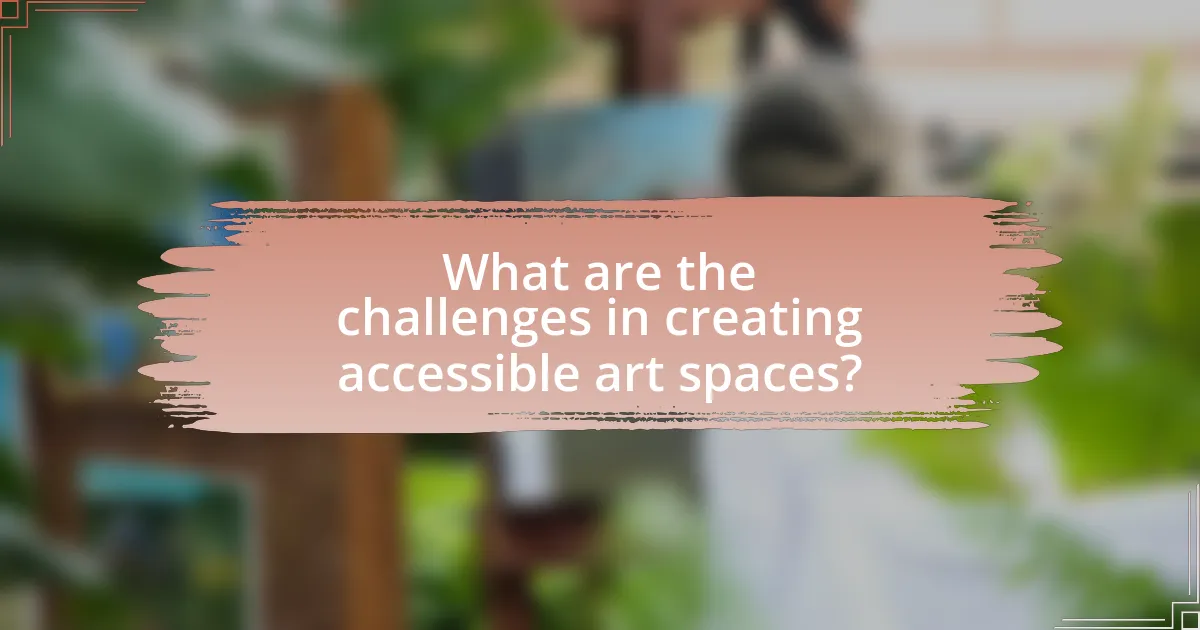
What are the challenges in creating accessible art spaces?
Creating accessible art spaces faces several challenges, including physical barriers, financial constraints, and a lack of awareness about inclusivity needs. Physical barriers, such as inadequate wheelchair access and poorly designed layouts, hinder participation for individuals with disabilities. Financial constraints often limit the ability of organizations to implement necessary modifications or provide adaptive technologies. Additionally, a lack of awareness among artists and administrators about the importance of inclusivity can result in spaces that do not cater to diverse audiences. According to a report by the National Endowment for the Arts, only 28% of arts organizations have made significant efforts to improve accessibility, highlighting the ongoing need for awareness and action in this area.
What common obstacles do organizations face in implementing accessibility measures?
Organizations commonly face budget constraints, lack of awareness, and insufficient training when implementing accessibility measures. Budget constraints limit the financial resources available for necessary modifications and technologies, making it difficult to achieve compliance with accessibility standards. Lack of awareness among staff and leadership about the importance of accessibility can lead to neglect in prioritizing these measures. Additionally, insufficient training for employees on accessibility best practices can hinder effective implementation, resulting in environments that remain inaccessible to individuals with disabilities. These obstacles collectively impede the progress toward creating inclusive art spaces.
How can funding and resources impact the creation of accessible art spaces?
Funding and resources significantly influence the creation of accessible art spaces by providing the necessary financial support for infrastructure, programming, and outreach initiatives. Adequate funding allows for the development of facilities that meet accessibility standards, such as wheelchair ramps, adaptive technologies, and sensory-friendly environments. For instance, a study by the National Endowment for the Arts found that organizations with dedicated funding for accessibility initiatives were 40% more likely to implement effective programs that cater to diverse audiences. Additionally, resources enable partnerships with local communities and organizations, enhancing outreach efforts to underrepresented groups. This financial backing is crucial for ensuring that art spaces are not only physically accessible but also inclusive in their programming and engagement strategies.
What are the legal requirements for accessibility in art spaces?
The legal requirements for accessibility in art spaces primarily stem from the Americans with Disabilities Act (ADA), which mandates that public accommodations, including art galleries and museums, must be accessible to individuals with disabilities. This includes ensuring physical access through ramps, elevators, and accessible restrooms, as well as providing auxiliary aids and services for effective communication, such as sign language interpreters or Braille materials. Compliance with the ADA is enforced by the Department of Justice, and failure to meet these requirements can result in legal action and penalties. Additionally, state and local laws may impose further accessibility standards that art spaces must adhere to, reinforcing the necessity for inclusivity in the arts.
How can these challenges be overcome?
To overcome challenges in creating accessible art spaces, organizations must implement inclusive design principles and engage with diverse community members. Inclusive design ensures that art spaces accommodate individuals with varying abilities, while community engagement fosters understanding of specific needs. Research by the National Endowment for the Arts indicates that inclusive practices can increase participation rates by up to 30%, demonstrating the effectiveness of these strategies in enhancing accessibility and community involvement.
What best practices can organizations adopt to enhance accessibility?
Organizations can enhance accessibility by implementing universal design principles, ensuring that spaces and services are usable by all individuals regardless of their abilities. This includes providing physical access through ramps and elevators, offering alternative formats for information such as braille and audio descriptions, and ensuring digital content meets web accessibility standards like WCAG 2.1. Research indicates that organizations adopting these practices not only comply with legal requirements but also expand their audience reach, as approximately 15% of the global population experiences some form of disability, according to the World Health Organization.
How can advocacy play a role in improving accessibility in the arts?
Advocacy can significantly improve accessibility in the arts by raising awareness, influencing policy, and mobilizing resources to support inclusive practices. Through targeted campaigns, advocates can highlight the barriers faced by individuals with disabilities, prompting organizations to adopt more accessible facilities and programming. For instance, the National Endowment for the Arts reported that advocacy efforts have led to increased funding for accessible arts initiatives, demonstrating a direct correlation between advocacy and enhanced accessibility. Furthermore, advocacy groups often collaborate with artists and institutions to develop guidelines and best practices, ensuring that accessibility becomes an integral part of the artistic process.
What are some practical tips for creating accessible art spaces?
To create accessible art spaces, ensure physical accessibility by incorporating ramps, wide doorways, and designated parking for individuals with disabilities. Additionally, provide clear signage in multiple formats, including Braille and large print, to assist those with visual impairments. Implement flexible programming that accommodates various needs, such as sensory-friendly events and workshops tailored for different abilities. Furthermore, engage with the community to gather feedback and understand specific accessibility requirements, fostering an inclusive environment. Research indicates that inclusive art spaces enhance participation and creativity, benefiting both artists and audiences.
